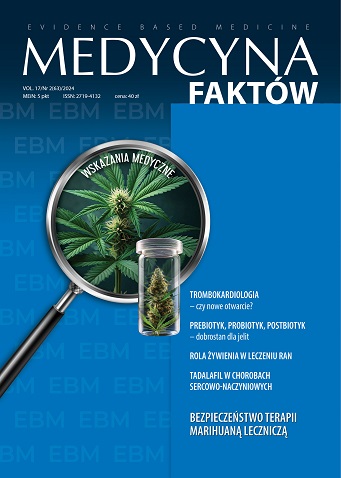Iniekcje tropokolagenu jako kluczowy element kompleksowego leczenia urazów sportowych Opis przypadku
##plugins.themes.bootstrap3.article.main##
Abstrakt
Standardowe metody leczenia urazów sportowych, takie jak ograniczenie aktywności fizycznej, farmakoterapia, fizjoterapia i zabiegi chirurgiczne, pochłaniają czas pacjentów. Dlatego poszukujemy innych metod leczenia, które nie pomijają niezbędnych, naturalnych cykli gojenia, a jedynie przyspieszają ich fazy przebiegu. Ze względu na potencjalne korzyści w przyspieszaniu procesów regeneracyjnych iniekcyjne terapie tropokolagenem stają się coraz bardziej popularną metodą będącą istotną częścią kompleksowej terapii urazów sportowych. Tropokolagen, będący prekursorem kolagenu, odgrywa kluczową rolę w regeneracji tkanki łącznej. Celem tego artykułu jest przedstawienie mechanizmów działania tropokolagenu oraz ocena jego skuteczności jako istotnej terapii uzupełniającej w optymalnym leczeniu urazów sportowych na wybranych przypadkach klinicznych. Przedstawiono dwa przypadki zastosowania tropokolagenu: u pacjenta, lat 25, trenującego biegi sprinterskie, u którego doszło do naderwania mięśnia czworogłowego, oraz u pacjentki, lat 32, trenującej amatorsko biegi długodystansowe, u której pojawiały się nawracające bóle okolicy kręgosłupa w trakcie biegu. W obu przypadkach w ramach modyfikacji terapii zastosowano iniekcje z tropokolagenu i uzyskano pożądany efekt terapeutyczny.
##plugins.themes.bootstrap3.article.details##
Copyright © by Medical Education. All rights reserved.
Bibliografia
2. Prieto-González P, Martínez-Castillo JL, Fernández-Galván LM et al. Epidemiology of Sports-Related Injuries and Associated Risk Factors in Adolescent Athletes: An Injury Surveillance. Int J Environ Res Public Health. 2021; 18: 4857. http://doi.org/10.3390/ijerph18094857.
3. Pavan PG, Stecco A, Stern R et al. Painful Connections: Densification Versus Fibrosis of Fascia. Curr Pain Headache Rep. 2014; 18: 441. http://doi.org/10.1007/s11916-014-0441-4.
4. Wilke J, Hespanhol L, Behrens M. Is It All About the Fascia? A Systematic Review and Meta-Analysis of the Prevalence of Extramuscular Connective Tissue Lesions in Muscle Strain Injury. Orthop J Sports Med. 2019; 7: 232596711988850. http://doi.org/10.1177/2325967119888500.
5. Angly B, Constantinescu MA, Kreutziger J et al. Early versus Delayed Surgical Treatment in Open Hand Injuries: A Paradigm Revisited. World J Surg. 2012; 36: 826-9. http://doi.org/10.1007/s00268-012-1455-x.
6. Handoll HH, Elliott J, Thillemann TM et al. Interventions for Treating Proximal Humeral Fractures in Adults. Cochrane Database Syst Rev. 2022; 2022: http://doi.org/10.1002/14651858.CD000434.pub5.
7. Ueblacker P, Haensel L, Mueller-Wohlfahrt HW. Treatment of Muscle Injuries in Football. J. Sports Sci. 2016; 34: 2329-37. http://doi.org/10.1080/02640414.2016.1252849.
8. Stephenson SD, Kocan JW, Vinod AV et al. A Comprehensive Summary of Systematic Reviews on Sports Injury Prevention Strategies. Orthop J Sports Med. 2021; 9: 232596712110357. http://doi.org/10.1177/23259671211035776.
9. Bell JS, Hayes S, Whitford C et al. Tropocollagen Springs Allow Collagen Fibrils to Stretch Elastically. Acta Biomater. 2022; 142: 185-93. http://doi.org/10.1016/j.actbio.2022.01.041.
10. Biryukov SY. On the Use of Type I Tropocollagen for Local Injection Therapy of Spine, Upper and Lower Extremity Disorders. Ter Arkh. 2023; 95: 1197-204. http://doi.org/10.26442/00403660.2023.12.202533.
11. Asgari M, Latifi N, Heris HK et al. In Vitro Fibrillogenesis of Tropocollagen Type III in Collagen Type I Affects Its Relative Fibrillar Topology and Mechanics. Sci Rep. 2017; 7: 1392. http://doi.org/10.1038/s41598-017-01476-y.
12. Goldberg B, Sherr CJ. Secretion and Extracellular Processing of Procollagen by Cultured Human Fibroblasts. Proc Natl Am Acad Sci. 1973; 70: 361-5. http://doi.org/10.1073/pnas.70.2.361.
13. Mariggi? MA, Cassano A, Vinella A et al. Enhancement of Fibroblast Proliferation, Collagen Biosynthesis and Production of Growth Factors as a Result of Combining Sodium Hyaluronate and Aminoacids. Int J Immunopathol Pharmacol. 2009; 22: 485-92. http://doi.org/10.1177/039463200902200225.
14. Duffy AM, Bouchier-Hayes DJ, Harmey JH. Vascular Endothelial Growth Factor (VEGF) and Its Role in Non-Endothelial Cells: Autocrine Signalling by VEGF. In Madame Curie Bioscience Database [Internet]; Landes Bioscience, 2013.
15. Mościcka P, Cwajda-Białasik J, Szewczyk MT et al. Healing Process, Pain, and Health-Related Quality of Life in Patients with Venous Leg Ulcers Treated with Fish Collagen Gel: A 12-Week Randomized Single-Center Study. Int J Environ Res Public Health. 2022; 19: 7108. http://doi.org/10.3390/ijerph19127108.
16. Kviatkovsky SA, Hickner RC, Cabre HE et al. Collagen Peptides Supplementation Improves Function, Pain, and Physical and Mental Outcomes in Active Adults. J Int Soc Sports Nutr. 2023; 20: 2243252. http://doi.org/10.1080/15502783.2023.2243252.
17. Massullo C. Injectable Guna Collagen Medical Devices in Functional Recovery from Sport Traumatology ? Guna Collagen Medical Devices. Physiol Regul Med. 2017; 3-7.
18. Corrado B, Bonini I, Tarantino D et al. Ultrasound-Guided Collagen Injections for Treatment of Plantar Fasciopathy in Runners: A Pilot Study and Case Series. J Hum Sport Exerc. 2020; 15: S793-805. http://doi.org/10.14198/jhse.2020.15.Proc3.30.
19. Milani L. A New and Refined Treatment for Musculo-Skeletal Disorders Bioscaffold Properties of Collagen and Its Clinical Use. Physiol Regul Med. 2010; 1: 3-15.
20. Ottaviani M. Treatment of Joint Conditions with Guna Collagen Medical Devices ? Clinical Study on 257 Patients. Physiol Regul Med. 2018.
